Leadership Training 13
Trainingchiefandteamleader
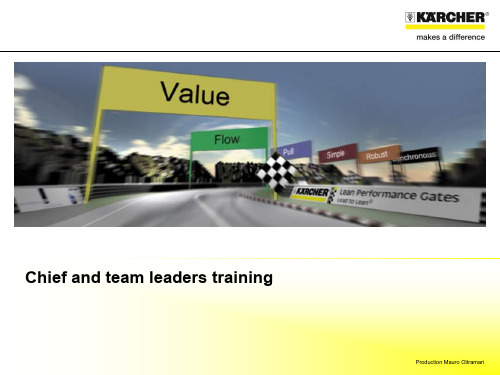
4. 开发你的团队所以他们才能成功——着重于挑 选态度良好以及具有互补技能的优秀队员
Be Professional and Trustworthy – Be immaculately dressed. Walk and talk with confidence (and humility)
1. 只着重于那些可以产生最大能量和注意力回馈 的重要增值活动
Focus only on the key value-adding activities that generate the biggest return on energy and attention
Communicate frequently with your immediate team – both through scheduled meetings and unscheduled calls and discussions
Chief and team leaders training
Production Mauro Oltramari
Leadership training
Laws of Leadership 领导力法则
Production Mauro Oltramari
The 21 Laws of Leadership 领导力的二十一条法则
Laws are the foundation of leadership 法则是领导力的基础
Once you learn the principles, you have to practice them and apply them to your life.
Production Mauro Oltramari
Production Mauro Oltramari
领导力培训 Leadership Training
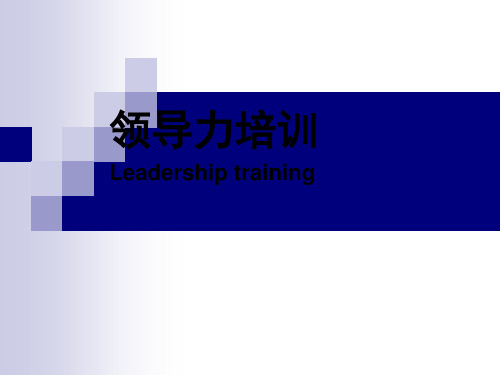
40000 30000 20000 10000
0 Jan Feb Mar Apr May Jun Jul Aug Sep Oct Nov Dec
2.0%
NQC
1.5%
1.0%
0.5%
0.0% Jan Feb Mar Apr May Jun Jul Aug Sep Oct Nov Dec
练习:列出你的主要指标及责任人
培训内容与方案
第一天 09:00-10:30 前言、学员发言 10:30-10:45 休息 10:45-12:15 SE领导力发展简介 12:15-13:15 午餐 13:15-14:45 回顾:管理基础 14:45-15:00 休息 15:00-16:30 从监工到经理导
第二天 09:00-10:30 从经理到领导 10:30-10:45 休息 10:45-12:15 变革管理 12:15-13:15 午餐 13:15-14:45 变革管理 14:45-15:00 休息 15:00-16:30 总结与行动计划
胜任能力胜任能力competenciescompetenciesknowledgeskillattitudebehaviorbehaviorsese能力模型轮廓能力模型轮廓领导力通用技巧专业技能专业知识sese能力模型能力模型leadership目标与策略创新进取影响带动结果导向专注顾客sese能力模型能力模型leadership团队协作支持授权学习适应核心团队sese能力模型能力模型crossfunction项目管理电脑运用财务基础文化融合解决问题sese能力模型能力模型crossfunction团体建设变革管理工作报告有效沟通社会协调自我评估练习自我评估练习l01l02l03l04l05l06l07l08l09c00入门胜任专家高手基本管理者成长历程3e3e1015education6070experience2025exposure管理者修炼三层面三拳两脚急需的管理技巧套路系统的管理知识方法具有普遍意义的哲理简单复杂简单人生的追求人生的追求生理安全社会尊重自我实现自我实现人生追求
leadership领导力 ppt课件

leadership领导力 ppt课件
6
1.Tannenbaum and Schmidt continuum 2.Rensis Likert Support Relation Theory 3.Chris Argyris Immature – Mature continuum 4. Blake and Mouton Managerial Grid 5.John Adair Action Centred Leadership
2. Autocratic 2 (A2) – you ask team members for specific information and once you have it, you make the decision. Here you don't necessarily tell them what the information is needed for. .
2021/3/26
leadership领导力 ppt课件
27
管理者的两种类型:
1. 任务导向型:task oriented 2. 人员导向型:relationship oriented
衡量管理情况的三个维度:
1.Position and authority 领导者的权利和地位 2.Objective structure 任务结构
Contigency Theory
三选一
2021/3/26
leadership领导力 ppt课件
26
1.Fiedler’s Contingency Theory 菲德勒的权变管理思想
中心思想:不同管理(situation)情况适用 不同领导风格(leadership behaviour)—— 把人放进情况里
Leadership Training_new
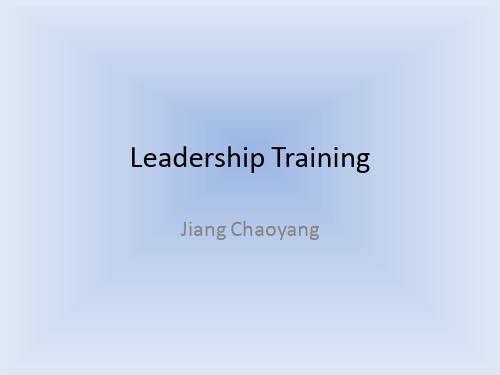
AGREE
• Agree on the ideas that were developed and support those who will take action.
• You should: a) Specify what will be done, who will do it and by when b) Agree on any follow-up actions needed to track progress in carrying out the plan c) Be sure to agree on needed resources or support
Listen and Respond with Empathy
• Empathy (同理心):Empathy covers a broad spectrum, ranging from feeling a concern for other people that creates a desire to help them, experiencing emotions that match another person's emotions, knowing what the other person is thinking or feeling, to blurring the line between self and other.
Leadership领导力课件
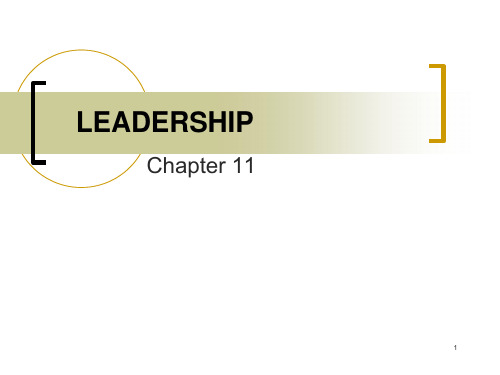
7
The Great Man Theory
➢ Early explanations of leadership studied the “traits” of great leaders
▪ “Great man” theories (Gandhi, Lincoln, Napoleon) ▪ Belief that people were born with these traits and
➢ Practically
▪ productively, economically, idealistically
➢ Personally
▪ interpersonally, ethically, selfishly
➢ Scientifically
▪ empirically, conceptually
He or she may be someone you work with now or someone you knew in the past. This coworker does not have to be the person you like least but should be the person with whom you had the most difficulty in getting a job done.
Criticisms include most of research was in the lab
16
Path-Goal Theory (House 1971)
Path-goal theory focuses on the kinds of leader behaviors that allow subordinates to achieve personal and organizational goals
供电公司青工培养计划措施和方案
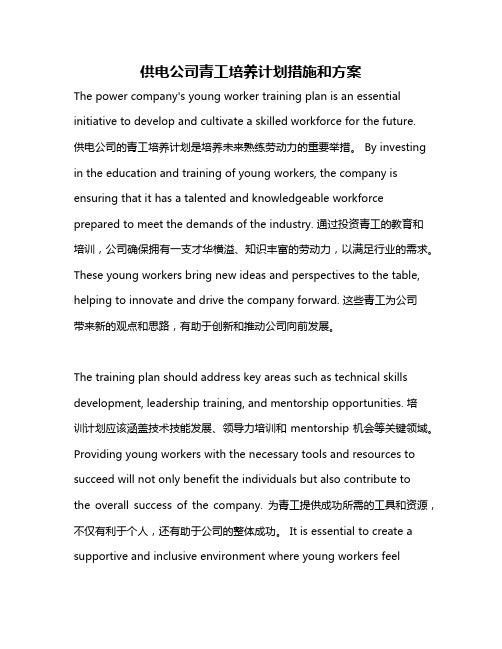
供电公司青工培养计划措施和方案The power company's young worker training plan is an essential initiative to develop and cultivate a skilled workforce for the future.供电公司的青工培养计划是培养未来熟练劳动力的重要举措。
By investing in the education and training of young workers, the company is ensuring that it has a talented and knowledgeable workforce prepared to meet the demands of the industry. 通过投资青工的教育和培训,公司确保拥有一支才华横溢、知识丰富的劳动力,以满足行业的需求。
These young workers bring new ideas and perspectives to the table, helping to innovate and drive the company forward. 这些青工为公司带来新的观点和思路,有助于创新和推动公司向前发展。
The training plan should address key areas such as technical skills development, leadership training, and mentorship opportunities. 培训计划应该涵盖技术技能发展、领导力培训和 mentorship 机会等关键领域。
Providing young workers with the necessary tools and resources to succeed will not only benefit the individuals but also contribute tothe overall success of the company. 为青工提供成功所需的工具和资源,不仅有利于个人,还有助于公司的整体成功。
Leadership领导力学习教程
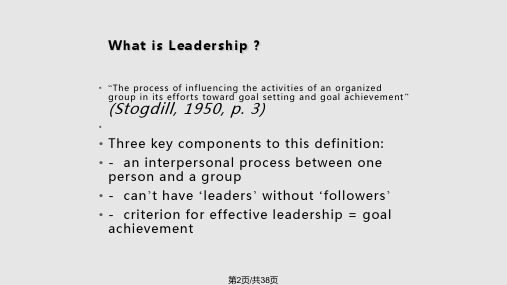
第4页/共38页
Leadership myths (cont.)
➢Leaders make or break their groups
• The “romance of leadership” exaggerates the impact of a leader
Leaders do make a difference (e.g., sports teams)
• Four leadership styles can be adopted to facilitate employee attainment of goals
• Directive
第16页/共38页
Path-Goal Situations and Preferred Leader Behaviors
needed to be a successful leader).
Implicit leadership theories (ILTs):
members general beliefs about the qualities of leaders Eagly’s social role theory: ILTs are not consistent wit第h9页in/共t3u8页itive expectations
• Control depends on relationship between leader/followers, the degree of task structu第re11,页a/共n38d页 the leader's
The LPC Scale
Measuring
Motivational Style
➢ Low LPC leaders most effective in very favorable or very unfavorable situations
情境领导力培训材料Situational Leadership Training
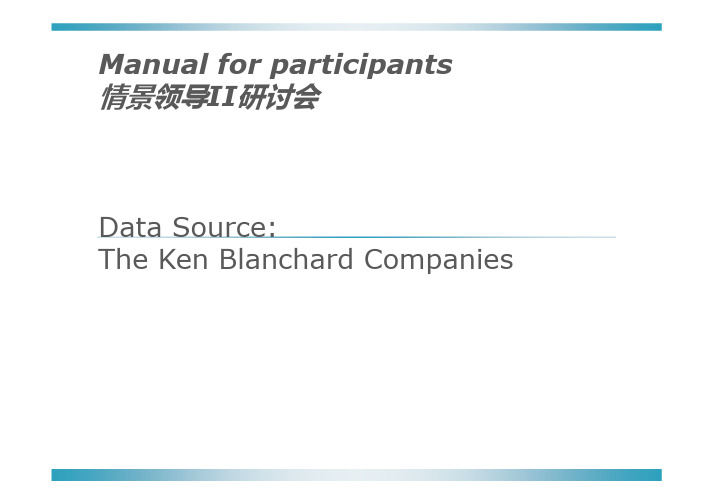
Manual for participants情景领导II研讨会Data Source:The Ken Blanchard CompaniesDefinition定义“情境领导”模式:在领导和管理公司或团队时,不能用一成不变的方法,而要随着情况和环境的改变及员工的不同,而改变领导和管理的方式。
管理的重点在于领导者自身。
2情境领导II的目的Open up communication 打开沟通Help others develop competence and commitment 发展能力和意愿Teach others how to provide their own direction and support 帮助员工自我发展Value and honor differences. 珍惜不同Three Skills of a Situational Leader 情境领导的三种技巧Diagnosis 诊断Flexibility因材施教Partnering 合作伙伴基本的改变Boss老板, Evaluator评估者, Judge法官and Critic 批评家Partner伙伴, Facilitator 促动者, Cheerleader 啦啦队队长, Supporter 支持者and Coach教练.Benefits of SL2 好处When leaders are situational leaders, the people who work with and peers当所有领导都是情境领导,其同事和员工会:公司里少紧张气氛认为他们的领导愿意改变或者接受新的观念或者方法认为他们的领导愿意帮助他们成长认为他们的领导是训练有素的更高的士气感觉被授权展现更多的自我领导研究显示当公司实施了情境领导以后-更强的领导力更高的员工满意度更低的流失率更高的客户满意度利率提高销量提高7Diagnosis: The First Skill of a Situational Leader 诊断:情境领导的第一种技巧发展水平Development Level Situations depending on team members’competence and commitment levels to a specific goa l or task情景关注团队成员在一个任务任务任务或目标目标目标上能力和意愿水平.Competence (Demonstrated Knowledge, not potential or intelligent)能力(外显的知识,不是潜在的或理解力方面的)-Goal or Task Knowledge and skills. 任务相关的技巧-Transferable knowledge and skills. 可转换的技巧Commitment 意愿-Motivation 动机-Confidence. 自信The Four Development Levels四个发展水平D1Low Competence High Commitment低能力,高意愿D2Low to Some Competence Low Commitment低能力,低意愿D3Moderate to High Competence Variable Commitment中等到高的能力,变化的意愿D4High Competence High Commitment高能力,高意愿五个用来诊断发展水平的关键问题 任务或者目标?所展现的与任务相关的知识和技能?可转移的技巧?动力,兴趣,或者热情?自信心?The Need of Each Development Level 每个发展水平的需求The Need of D1—The Enthusiastic Beginner 热情洋溢的初学者Recognition of enthusiasm and transferable skills(认可热情和可转换的技巧)Clear goals and roles(清晰的目标和角色)Standards for what a good job looks like(设置何为好工作的标准)Timelines(时间限制)Priorities (优先顺序)Information on how data about performance will be collected and shared(分享绩效如何被收集的信息),,)Action plans—specific direction about how, when and with whom(行动计划-关于如何开展,何时开展,与谁一起开展给予明确的方向)Boundaries and limits (界限)The unwritten rules on “how things work around here” (不成文的规定)Information about the goal or task and the organization(分享组织目标和任务的信息)A step-by-step process for learning new skills(逐步学习新技巧的过程)Concrete examples of how others accomplish the goal or task (具体的例子)Opportunities to practice (练习的机会)Frequent feedback on results (频繁的反馈) Solutions to problems (解决方案)The Need of D2—The Disillusioned Learner困惑的学习者Clear goal(明确的目标)Frequent feedback(频繁反馈)Praise for making progress(赞扬进步)Help in analyzing success and failures; assurance that it is okay to make mistakes(分析成功和失败)Explanations of why the goal or task is important and explanations of “how”(解释为什么目标和任务是重要的合解释如何重要)Opportunities to discuss concerns and share feelings(讨论顾虑和分享感受)Involvement and influence in decision making and problem solving(参与和影响决策制定和解决问题的过程)Encouragement(鼓励)Advice and additional next steps and alternatives (备选方案)Coaching to build and refine skills(指导建立和完善工作技巧)The Need of D3—The Capable, but Cautious Performer能干的,但小心的贡献者An approachable mentor or coach (导师或者教练)Opportunities to test ideas(提供尝试新想法的机会)Opportunities to express concerns and share feelings(表达担忧和分享感受的机会)Support and encouragement to develop self-reliant problem solving skills(支持和鼓励发展自我解决问题的技巧)Help in looking at experience and skills objectively, so confidence is built(帮助员工客观识别自我经验和技巧,建立自信)Praise and recognition for high levels of competence and performance(赞扬和认可高能力和绩效)Obstacles to goal accomplishment removed(移去障碍)A kick-start to overcome delay(克服延迟)The Need of D4—The Self-Reliant Achiever独当一面的目标达成者Variety and challenge (多样性和挑战)A leader who is more of a mentor and colleague than amanager(需要导师或同伴式的领导)Acknowledgement of contributions(对贡献的认可)Autonomy and authority (自由和自主权)Trust (信任)Opportunities to share knowledge and skills with others(有机会与别人分享知识和经验)Flexibility: The Second Skill of a Situational Leader 灵活性:情境领导的第二种技巧Leadership Behavior 领导行为Directive Leadership Behavior Vs. Supportive Leadership Behavior指导性行为和支持性行为(D & S)Directive Leadership Behavior指导性Sets goals and clarified expectations设立目标,澄清期望Tells and shows an individual what to do, when, and how to do it 告诉并呈现做什么,什么时候做,如何做Closely supervises, monitors, and evaluates performance. 密切监督,监管和评估业绩19Supportive Leadership Behavior支持性Engages in more two-way communication投入到双向沟通的过程中Listens and provides support and encouragement 聆听并提供支持和鼓励Involves the other person in decision making 让别人参与决策的过程Encourages and facilitates self-reliant problem solving 鼓励并促进自我解决问题的能力20Using Directive Behavior运用指导性行为Goal Setting设置目标Developing Action Plans发展行动计划 Clarifying Roles澄清角色Showing and Telling How呈现和告知如何做Evaluating评估Establishing Timelines建立时间限制Setting Priorities优先顺序Using Supportive Behavior运用支持性行为Listening and Confirming You Heard聆听和确认听到了Praising and Encouraging赞扬和鼓励Sharing information about the Organization, Goal, or Task分享关于组织,目标和任务的信息Sharing information about self分享自我信息Facilitating Self-reliant Problem Solving促进自我解决问题的能力Asking for input询问意见Providing Rational and Explaining Why提供合理性建议和解释为什么Leadership Style 1(S1) –Telling / Directing领导风格1(S1)-告知/指导S1: High directive and low supportive behavior高指导低支持Template for Style 1:S1模板--Find something to acknowledge寻找需要告知的领域--Give direction-teach or show how给予指导-教育或者亲自示范如何做--Check for understanding检查是否理解Style 1: Intension意图You really want to help others develop their competence!你想帮助别人发展他们的自身能力!Leadership Style 2 (S2) –Selling / Coaching领导风格2(S2)-推销/教练S2: High Directive and High Supportive Behavior高指导和高支持Template for Style 2: S2模板-Find something to praise找到可以赞扬的方面-Lead with your ideas and explain why指导你的想法和解释为什么-Consult and listen咨询和聆听-Make the final decision做出最终决定Style 2: Intension意图You want to show your care! To build others’ competence and commitment 你想要显示你的关心!你要建立别人的能力和意愿。
领导力提升(讲师版)

获得渠道 •积累 •Mentoring
一致, 灵活virtue team.ppt
海尔高级经理人领导力模型
远景部署 突破思维 洞察市场
布局全球
理性决策
对海尔美誉全球的追求
部属培育
决胜长远
战略承接
构建 横向整合 运营能力
13
民生银行零售银行能力素质模型
10项核心能力 6项专业能力
团队建 设 商业礼 仪 学习能 力 敬业 团队协 作
52 47 51
53
49
51
52 48 51
50
50 48
45 50 43 42 49
47
48 46
45 46 45 44 37 40 43 42 36 35 33 37 27 26 23 33 23 24 25 26 16 17 18 19 20 21 22 23 24 25 26 16 17 18 19 20 21 22 15 16 17 10 11 12 13 14 44 43 42 38 39 38 37 32 31 29 19 20 21 22 12 13 14 15 16 17 18 17 18 19 11 12 13 14 15 16 31 38 40 40 47 46 45 41 41 43 43
人员发 展 沟通影 响
客户 导向
营销 策划
专业 能力
核心 能力
理财 规划
变革管 理
绩效导向
执行力
培训 能力 业务 知识
14
业务 经营
坚持以事实和制度为基础
情景描述
某日晚上九点半左右,某大卖场出纳员李文哲正在清点现 金存量。一个身体魁梧的匪徒突然持枪指令他交出全部现金。 李文哲照办。匪徒在无任何阻碍之下冲出大卖场大门,并跳 进一部在外接应的车子。李文哲一俟该匪徒冲出大门,立刻 按警铃,并且在几十秒之内跳上停放在大卖场门口那辆属于 自己的摩托车,死命地追逐匪车。在某一十字路口,适逢火 车经过,匪车不得不停下来,李文哲就在这个时候赶到。说 时迟那时快,李文哲逮住其中的一个匪徒。纠缠中,李文哲 的左腿挨了一枪,但他仍不放弃。就在那千钧一发的时候, 警车开到了,不但替李文哲解了围,而且也逮捕了两个匪徒。
培训计划安排英语咋说

培训计划安排英语咋说IntroductionThe purpose of this training plan is to provide a structured and comprehensive approach to training employees within the organization. The plan will outline the training needs of the employees, the goals and objectives of the training program, and the specific activities and resources that will be used to achieve these goals. The training plan will also include a timeline for the training program and an evaluation process to measure the effectiveness of the training.Training Needs AssessmentThe first step in developing a training plan is to conduct a training needs assessment. This involves identifying the knowledge, skills, and abilities that employees need to perform their job duties effectively. The needs assessment may involve conducting surveys, interviews, or observations to determine the training needs of the employees. Once the training needs have been identified, the next step is to develop specific training objectives and goals.Training Objectives and GoalsThe training objectives and goals should be specific, measurable, achievable, relevant, and time-bound (SMART). This means that the objectives should clearly outline the knowledge, skills, and abilities that the employees will need to acquire as a result of the training program. The goals should also specify the time frame in which the training will take place and the criteria that will be used to measure the success of the training program.Training Activities and ResourcesThe training activities and resources will be selected based on the specific needs of the employees and the goals of the training program. This may involve a combination of classroom training, on-the-job training, online training, mentorship, and coaching. The resources may include training materials, equipment, facilities, and trainers. The training activities and resources should be aligned with the overall objectives and goals of the training program.TimelineThe timeline for the training program will outline the specific dates and deadlines for each training activity. This will ensure that the training program stays on track and that all training activities are completed in a timely manner. The timeline will also include the dates for pre-training assessments, training sessions, post-training assessments, and any follow-up activities.EvaluationThe evaluation process will measure the effectiveness of the training program and provide feedback for continuous improvement. This may involve conducting pre-training assessments to measure the employees' existing knowledge, skills, and abilities, as well as post-training assessments to measure the impact of the training program. The evaluation process may also involve gathering feedback from the employees and their supervisors to identify any areas for improvement.Training Plan ScheduleBased on the training needs assessment, the following training plan schedule has been developed:Training Objective: Improve Customer Service SkillsGoal: Increase customer satisfaction ratings by 10% within 6 monthsTraining Activities:1. Classroom training on effective communication and problem-solving skills2. On-the-job training with experienced customer service representatives3. Role-playing exercises to practice handling difficult customer situations4. Computer-based training on company policies and proceduresResources:- Training materials on effective communication and problem-solving- Computer training software on company policies and procedures- Experienced customer service representativesTimeline:- Pre-training assessments: Week 1- Classroom training: Weeks 2-4- On-the-job training: Weeks 5-8- Role-playing exercises: Weeks 9-10- Computer-based training: Week 11- Post-training assessments: Week 12Evaluation:- Pre-training and post-training assessments- Customer satisfaction surveys- Feedback from employees and supervisorsTraining Objective: Enhance Leadership SkillsGoal: Increase employee engagement and retention by 15% within 9 months Training Activities:1. Leadership development workshops on effective communication and team building2. Mentorship and coaching with senior managers3. Project management training4. Conflict resolution trainingResources:- Leadership development materials- Project management training materials- Experienced senior managers for mentorship- Conflict resolution training materialsTimeline:- Pre-training assessments: Week 1- Leadership development workshops: Weeks 2-5- Mentorship and coaching: Weeks 6-8- Project management training: Weeks 9-12- Conflict resolution training: Weeks 13-14- Post-training assessments: Week 15Evaluation:- Pre-training and post-training assessments- Employee engagement surveys- Feedback from employees and supervisorsConclusionThe training plan schedule outlined above provides a systematic approach to training employees within the organization. By identifying the specific training needs of the employees, setting clear objectives and goals, and selecting appropriate training activities and resources, the organization can ensure that the training program is effective in improving employee knowledge, skills, and abilities. The timeline and evaluation process will also help to measure the impact of the training program and identify any areas for improvement. By following this training plan schedule, the organization can enhance the overall performance and productivity of its employees.。
领导力培训 Leadership Training(课堂PPT)
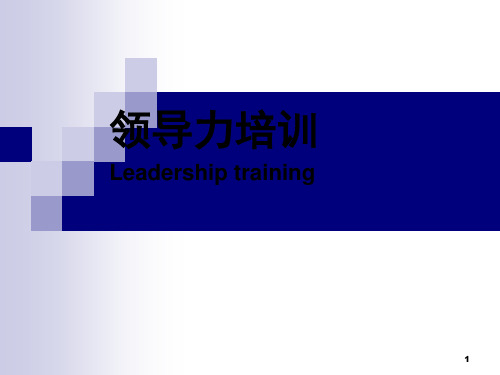
15
SE能力模型 (CrossFunction 2)
团体建设 变革管理
工作报告 有效沟通 社会协调
16
自我评估练习
入门 基本 胜任 高手 专家
L01 L02 L03 L04 L05 L06 L07 L08 L09
C00 C00 C00 C00 C00 C00 C00 C00 C00 C01 1234567890
我愿
Attitude
Skill 我会
11
SE能力模型轮廓
目 标 认 知
授 权 与 育 人
实 现 目 标
影 响 与 说 服 力
沟 通 技 巧
分 析 解 决 问 题
计 算 机 使 用
3 2 1 3 2
1
专 业 技 能 (
)
专 业 技 能 (
)
专 业 技 能 (
)
专 业 知 识 ( )
专 业 知 识 (
)
专 业 知 识 (
)
领导力
通用技巧
专业技能
专业知识
12
SE能力模型 (Leadership 1)
目标与策略 创新进取 影响带动
结果导向 专注顾客
13
SE能力模型 (Leadership 2)
团队协作 支持授权 学习适应 核心团队
14
SE能Байду номын сангаас模型 (CrossFunction 1)
项目管理 电脑运用
Culture
制定计划
沟通
COMPETENCE (我能)
Skill & Knowledge Behaviour & Attitude
团队建设
高绩效团队领导力训练-七层次领导力训练

七层次领导力训练Seven Levels of Leadership®training《高绩效团队领导力训练》概述《高绩效团队领导力训练》是提升个人领导力的有效方法,是杨俊杰领导力理论的最新发展的研究成果,其发现领导力在进入21世纪,领导力理论获得了新突破和发展,往人性方向迈进。
主要的理论包括埃美特的领导政治理论、麦加维(BlytheMcGarvie)财务敏感型领导力、Earce和Sims的共享领导力、格林里夫的服务型领导理论、共鸣领导力、教练型领导、丹尼尔·戈尔曼(Daniel Goleman)的情商领导力(Emotional Intelligence)、罗伯特·豪斯(Robert J.House)的价值领导力在此基层上催生了价值驱动型的七层次领导力,《高绩效团队领导力训练》国际版权就是价值驱动型的七层次领导力的研究成果。
理论依据《高绩效团队领导力训练》是在亚伯拉罕·马斯洛(Abraham Harold Maslow)的五层次需求理论和罗伯特·豪斯(Robert J. House) 的目标路径理论,罗伯特·豪斯的综合激励模式,罗伯特·豪斯的魅力型领导,罗伯特·豪斯的价值领导力,理查德·巴雷特的七层次领导力为基层,产生价值驱动的七层次领导力的理论下研发的领导力训练方法。
高绩效团队领导力训练- 应用背景在企业管理者学了很多领导技能为什么用不上?团队的业绩老是起伏或者难突破?领导者个人或者整个团队总是达不到公司的要求?众多的困惑一直围绕着团队直接领导者和高层管理者,正是这样的背景下才使得《高绩效团队领导力训练》与实际相结合。
实际应用《高绩效团队领导力训练》在企业管理中能够帮助管理者解决以下实际问题:辅导高层管理者如何去领导手下干将,帮助团队直接领导者如何领导并带领团队不断创出佳绩并能持久成功。
1、掌握七层次领导力模型,活用各类领导技能;2、评估并获知个人所在领导力层次,明确领导力进化方向;3、从模拟训练中掌握领导团队的技巧并发现问题所在;4、帮助建设高绩效团队,逐步实现从优秀走向卓越;5、积极自主的学习氛围、融合与实际工作案例结合的激烈的思维激荡,有效实现知行转化。
大学生培养领导力的重要性英语作文
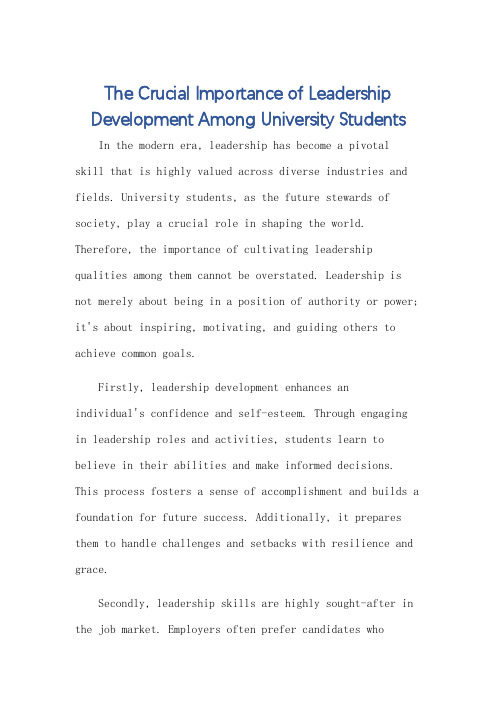
The Crucial Importance of Leadership Development Among University StudentsIn the modern era, leadership has become a pivotalskill that is highly valued across diverse industries and fields. University students, as the future stewards of society, play a crucial role in shaping the world. Therefore, the importance of cultivating leadership qualities among them cannot be overstated. Leadership is not merely about being in a position of authority or power; it's about inspiring, motivating, and guiding others to achieve common goals.Firstly, leadership development enhances anindividual's confidence and self-esteem. Through engaging in leadership roles and activities, students learn to believe in their abilities and make informed decisions. This process fosters a sense of accomplishment and builds a foundation for future success. Additionally, it prepares them to handle challenges and setbacks with resilience and grace.Secondly, leadership skills are highly sought-after in the job market. Employers often prefer candidates whopossess strong leadership qualities as they contribute significantly to team performance and organizational success. University students who cultivate these skills during their academic tenure are more likely to land rewarding job opportunities and excel in their careers.Moreover, leadership development encourages students to be active contributors to society. As leaders, they are more inclined to identify problems, initiate change, and collaborate with others to bring about positive transformations. This attitude and behavior are essential for building a stronger, more inclusive, and sustainable society.Furthermore, leadership training equips students with the skills necessary to manage diverse teams effectively. In a world that is increasingly globalized and multicultural, the ability to work with people from different backgrounds and perspectives is crucial. Leadership training helps students develop a strongcultural sensitivity, adaptability, and conflict resolution skills, enabling them to lead diverse teams successfully.Lastly, leadership development fosters a sense of responsibility and accountability. Leaders are often looked upon as role models and are expected to set examples for others to follow. This expectation encourages students to uphold high ethical standards and be accountable for their actions. It also inspires them to make positivecontributions to society and be agents of change.In conclusion, the importance of leadership development among university students cannot be understated. It notonly enhances their personal growth and development butalso prepares them for successful careers and active rolesin society. Therefore, universities should prioritize leadership training and provide students with ample opportunities to develop these crucial skills.**大学生培养领导力的重要性**在当今时代,领导力已成为各行各业高度重视的核心技能。
Leadership(卓越领导力和领导艺术)培训课件

卓越领导力和领导艺术李世昌Stephen Li2012年4月21日课程提纲 创新变革者——学习力及其艺术组织领导者——影响力及其艺术团队建设者——凝聚力及其艺术人性沟通者——表达力及其艺术工作教练者——指导力及其艺术人才选用者——开发力及其艺术能力发展者——培养力及其艺术战略管理者——决策力及其艺术绩效驱动者——激励力及其艺术开场白领导力(Leadership):一个人最重要的资产企业层面:个人领导力团队领导力组织领导力没有领导力就没有执行力!创新变革者——学习力及其艺术1.“我是拥有智慧的我是拥有智慧的,,但我拥有的是昨天的智慧但我拥有的是昨天的智慧。
”——杰克·韦尔奇2. “与改变世界相比与改变世界相比,,改变自己更困难”。
——曼德拉 3. 人最难的就是始终要有初学者的心态人最难的就是始终要有初学者的心态!!——乔布斯学习型组织 自我超越改善心智模式共同愿景团队学习系统思考彼得.圣吉的代表作《第五项修炼——学习型组织的艺术与实务》1990年在美国出版该书在1992年获世界企业学会最高荣誉开拓奖圣吉本人也同年被美国《商业周刊》推崇为当代最杰出的新管理大师之一。
《第五项修炼第五项修炼》》命运性格习惯行为观念观念((思想思想))心态认知学习态度态度,,观念观念,,习惯习惯的的改变改变会会很难。
eg. 十指交叉游戏但往往但往往不习惯的时候就是成长的时候不习惯的时候就是成长的时候居安思危革故鼎新自强不息穷变通久Video:鹰之重生鹰之重生“取得成功的方法就是取得成功的方法就是757575--80%80%靠领导靠领导靠领导,,其余其余202020--25%25%靠管理靠管理靠管理,,而不能反过来而不能反过来。
”——约翰-科特(John P. Kotter)美国哈佛大学终身教授,2001年10月,《商业周刊》杂志称其为美国第一“领导力大师”2004年被评为全世界最具声望的五位管理和商业领袖之一。
领导与管理执行力特训
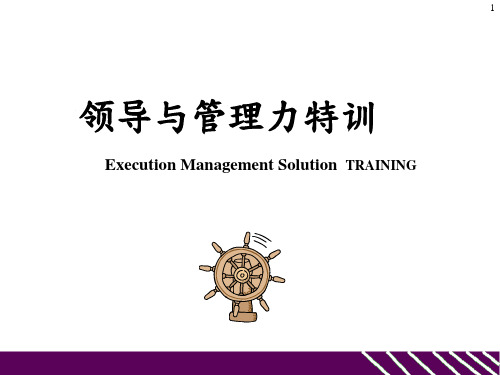
17
管理的五项工作和内容
管理的五项工作
计划 组织 协调 控制 监督
管理的五项内容
人员 资产 设备 工作流程 信息 时间
18
要领导不要管理 山姆威顿story四现;定立标准
顺序
旧的领导风格
新的领导风格
1
監督
協助
2
命令
沟通
3
训戒
建议
4
竞争
5
产量
6
秘密
7
担心
8
为谁工作
合作 品质 公开 信任 和谁工作
28
单元二:主管管理技能提升
如何提高能力
五建立学习型的组织 戈巴乔夫 sony 六跟进追踪报表运用;东元电机我孙子厂 •1 作用:PDCA循环的重要环节; •2 方法:制定各项具体措施;建立定期检查 汇
报 讲评制度;深入现场;及时解决瓶颈问题; 关注细节
29
单元二:主管管理技能提升
如何提高能力
七指导——提高员工的能力和素质 •1 首先观察一个人的行为;然后向他提供具体而
赞赏 倾听 协助
•授权式 领导者将决策制定和解决问题的 能力很强;也非常敬 把日常制定决策
Delegating 责任交由部属负责
业
的责任交由部属
单元二:主管管理技能提升
23
惩戒的烫炉原则
预警 即时 公平 持续
24
单元二:主管管理技能提升
什么是管理力
•1 是一门学问;它是 经营战略的内在组成部分
•2 是领导者的主要工作 •3 应当是文化中的核心元素 •4 目標達成的依據
核改
定
象
限制
善
单元二:主管管理技能提升
有效授权
Leadership training

商务礼仪之仪容仪表 男士篇
1. 男士的发型发式标准就是干净整洁,要注意经常修饰、修 理。头发不应该过长,前部的头发不要遮住眉毛,侧部的 头发不要盖住耳朵,后部的 头发不要长过西装衬衫领子的 上部,头发不要过厚,鬓角不要过长。 2. 男士在进行商务活动的时候,每天要进行剃须修面以保持 面部清洁;要随时保持口气的清新。
25
总结
图难于其易,为大于其细 言善信,政善治,事善能,动善时 善为士者,不武;善战者,不怒;善胜敌者,不与; 善用人者,为之下. 是谓用人之力 为人己愈有,与人己愈多 不行而知,不见而明,不为而成
26
Thank You
27
15
交ห้องสมุดไป่ตู้名片的礼仪
1. 如果是坐着,尽可能起身接受对方递来的名片 2. 接受名片时,应以双手去接,并确定其姓名和职务 3. 接受名片后,不宜随手置于桌上 4. 不可递出污旧或皱折的名片 5. 名片夹或皮夹置于西装内袋,避免由裤子后方的口袋掏出 6. 尽量避免在对方的名片上书写不相关的东西 7. 不要无意识地玩弄对方的名片 8. 上司在 时不要先递交名片,要等上司递上名片后才能递上
4. 加强领导三力
思考力 决策力
执行力
5. 正确的对待员工态度
1. 有意愿 有能力 2. 有意愿 无能力 4. 3. 无意愿 有能力 无意愿 无能力
7
意愿 – 愿意投入工作的意愿 能力 – 完成任务的能力
领导者的能力
6. 领导者对工作和生活的态度
AQ
3Q
IQ EQ
7. 领导者的典范权
弱
合法权 – 组织制定 报酬权 – 利益诱导 强制权 – 惩罚威胁 专家权 – 专业技能 (多元化能力)
23
最新领导力培训LEADERSHIP IN ORGANIZATIONS-1精品资料

leaders. Explain the five sources of power and how each causes different
subordinate behavior. Describe the leader behaviors of initiating structure and
consideration and when they should be used. Describe Hersey and Blanchard’s situational theory and its
Leadership Traits
Traits: the distinguishing personal characteristics
of a leader, such as intelligence, values, and appearance.
Personal Characteristics of Leaders
organizational characteristics can substitute for leadership behaviors. Describe transformational leadership and when it should be used. Explain innovative approaches to leadership in the new workplace.
Manager qualities
高思研-领导力提升训练内训(High---Siyan-leadership-training-tra
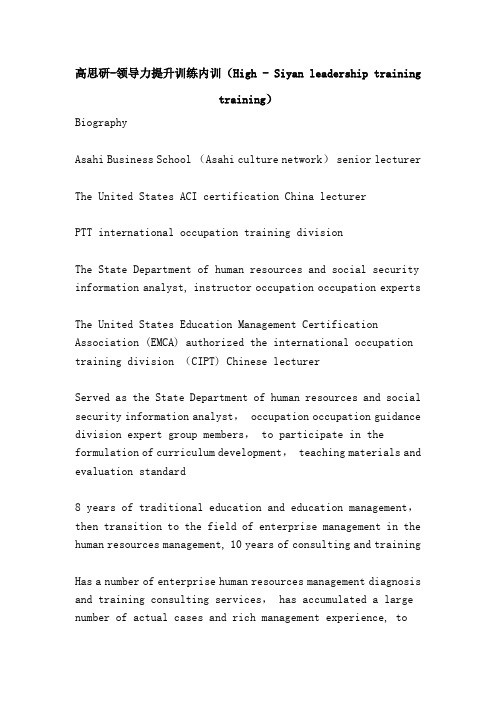
高思研-领导力提升训练内训(High - Siyan leadership trainingtraining)BiographyAsahi Business School (Asahi culture network) senior lecturerThe United States ACI certification China lecturerPTT international occupation training divisionThe State Department of human resources and social security information analyst, instructor occupation occupation expertsThe United States Education Management Certification Association (EMCA) authorized the international occupation training division (CIPT) Chinese lecturerServed as the State Department of human resources and social security information analyst, occupation occupation guidance division expert group members, to participate in the formulation of curriculum development, teaching materials and evaluation standard8 years of traditional education and education management,then transition to the field of enterprise management in the human resources management, 10 years of consulting and trainingHas a number of enterprise human resources management diagnosis and training consulting services, has accumulated a large number of actual cases and rich management experience, toprovide long-term training and consulting solutions for the enterprise, help the enterprise to establish and operate the human resources and training system。
领导力课程中英文培训资料

All Rights Reserved 2007
Rucci, et al, 1998
5
The Cost of a Bad Boss
不称职上司的代价
58% of people who have worked with subpar
managers are affected as follows:
注重客户和市场 支持变革
All Rights Reserved 2007
WB 3
成效驱动 将愿景转化为行动
9
Introduction 简介
What is your most important responsibility as a supervisor? 作为一名主管,你最重要的职责是什么?
To produce results ...
Traditional 过去
5% Strategy 策略谋划
15% Coaching, Developing,
Supporting, Building 辅导、发展、支持、培
养
80% Directing & Maintaining
指挥和管理
21st Century 21世纪
20% Strategy 策略谋划
领导包括激励他人追随、建立友好关系和对 他人提供支持。领导者所完成的事情,缺少 他们便无法成功。
All Rights Reserved 2007
WB 6
16
Leaders and Managers 领导者和管理者
• Aim Higher • 追求卓越
All Rights Reserved 2007
4
